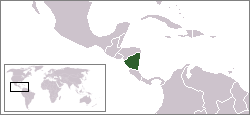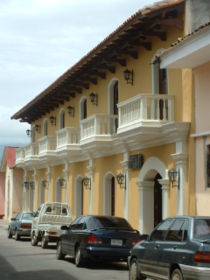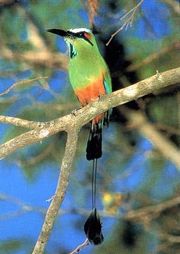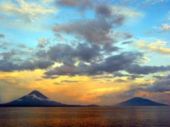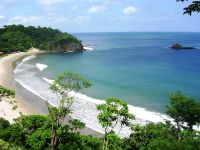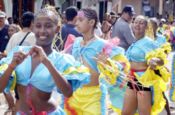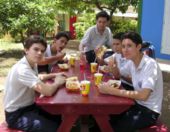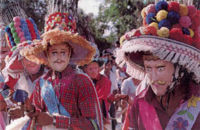Nicaragua
2007 Schools Wikipedia Selection. Related subjects: Central & South American Countries; Countries
| República de Nicaragua Republic of Nicaragua |
|||||
|
|||||
| Anthem: Salve a ti, Nicaragua | |||||
| Capital (and largest city) |
Managua |
||||
| Official languages | Spanish (official) (English and indigenous languages on Caribbean coast) | ||||
|---|---|---|---|---|---|
| Government | Republic | ||||
| - President | Enrique Bolaños | ||||
| Independence | From Spain | ||||
| - Declared | September 15, 1821 | ||||
| - Recognized | July 25, 1850 | ||||
| Area | |||||
| - Total | 129,494 km² ( 97th) 50,193 sq mi |
||||
| - Water (%) | 07.14 | ||||
| Population | |||||
| - July 2005 estimate | 5,487,500 ( 108th) | ||||
| - Density | 42/km² ( 157th) 109/sq mi |
||||
| GDP ( PPP) | 2005 estimate | ||||
| - Total | $20.996 billion ( 108th) | ||||
| - Per capita | $3,636 ( 119th) | ||||
| HDI (2003) | 0.690 (medium) ( 112th) | ||||
| Currency | Córdoba ( NIO) |
||||
| Time zone | ( UTC-6) | ||||
| Internet TLD | .ni | ||||
| Calling code | +505 | ||||
Nicaragua (Spanish: República de Nicaragua, IPA [re'puβlika ðe nika'raɰwa]) is a democratic republic in Central America. It is the largest nation in the isthmus, but also the least densely populated with a demographic similar in size to its smaller neighbours. The country is bordered on the north by Honduras and on the south by Costa Rica. Its western coastline is on the Pacific Ocean, while the east side of the country is on the Caribbean Sea.
The country's name is derived from Nicarao, the name of the Nahuatl-speaking tribe which inhabited the shores of Lago de Nicaragua before the Spanish conquest of the Americas, and the Spanish word Agua, meaning water, due to the presence of the large lakes Lago de Nicaragua and Lago de Managua in the region.
At the time of the Spanish conquest, Nicaragua was the name given to the narrow strip of land between Lake Nicaragua and the Pacific Ocean. Chief Nicarao ruled over that land when the first conquerors arrived. The term was eventually applied, by extension, to the group that inhabited that region: the Nicaraos or Niquiranos.
The Nicarao tribe migrated to the area from northern regions after the fall of Teotihuacán, on the advice of their religious leaders. According to tradition, they were to travel south until they encountered a lake with two volcanoes rising out of the waters, and so they stopped when they reached Ometepe, the largest fresh-water volcanic island in the world.
History
In 1524, Conquistador Francisco Hernández de Córdoba founded the first Spanish permanent settlements, including two of Nicaragua's principal towns: Granada on Lake Nicaragua and León east of Lake Managua. Settled as a colony of Spain within the kingdom of Guatemala in the 1520s, Nicaragua became a part of the Mexican Empire and then gained its independence as a part of the United Provinces of Central America in 1821 and as an independent republic in its own right in 1838. The Mosquito Coast based on Bluefields on the Atlantic was claimed by the United Kingdom and its predecessors as a protectorate from 1655 to 1850; this was delegated to Honduras in 1859 and transferred to Nicaragua in 1860, though it remained autonomous until 1894.
Much of Nicaragua's early politics following independence was characterized by the rivalry between the liberal élite of León and the conservative élite of Granada. This rivalry sometimes spilled into civil war. Initially invited by the liberals in 1855 to join their struggle against the conservatives, a United States adventurer named William Walker won the Liberals' war so easily that it seemed like he barely even fought. As a result, he saw the chance to take over the country. Walker named himself the president in 1856 with the intention of creating another slave state for the United States. Fearing the possibility of his plans for expansion, several Central American countries united to drive him out of Nicaragua in 1857, ironically supported by American industrialist Cornelius Vanderbilt, who had earlier sponsored Walker's filibuster of Nicaragua. Walker was executed in neighbouring Honduras on Sept. 12, 1860. A period of three decades of conservative rule ensued.
Taking advantage of divisions within the conservative ranks, José Santos Zelaya led a liberal revolt that brought him to power in 1893. Zelaya ended the long-standing dispute with the United Kingdom over the Atlantic Coast in 1894, and re-incorporated the Mosquito Coast into Nicaragua.
Nicaragua offered assistance during World War II, and was the first country in the world to ratify the UN Charter.
Nicaragua has seen many outside interventions and lengthy periods of military dictatorship, the longest one being the rule of the Somoza family for much of the 20th century. The Somoza family came to power as part of a US-engineered pact in 1927 that stipulated the formation of the National Guard to replace the small individual armies that had long reigned in the country. The only Nicaraguan general to refuse to sign this pact (el tratado del Espino Negro) was Augusto César Sandino who headed up to the northern mountains of Las Segovias, where he fought the US Marines for over five years.
The Marines eventually reached an agreement with the Sandinista guerrillas. The Marines left, and Juan Bautista Sacasa was left in control of the country. A National Guard was created and Anastasio Somoza Garcia, a man educated in the United States, obtained the highest position in the newly created organization.
From his position in the National Guard, Somoza effectively took over the country. Fearing future armed opposition from Sandino, Somoza invited him to a meeting in Managua, where he was assassinated on February 21 of 1934 by the National Guard. Somoza now had effectively taken control of the country and destroyed any potential armed resistance. He was assassinated in turn by Rigoberto Lopez Perez, a Nicaraguan poet, in 1956 . Luis Somoza Debayle, the eldest son of the late dictator, officially took charge of Nicaragua after his father's death.
Luis was in power only for a few years when he died of a heart attack. He is remembered for being moderate. Then came a puppet president, Rene Shick. Anastasio Somoza Debayle, who was in charge of the National Guard, held effective control of the country. He officially took the presidency after Shick. In 1961, a young student, Carlos Fonseca, turned back to the historical figure of Sandino, founding the Sandinista National Liberation Front (FSLN). The FSLN was a tiny party throughout most of the 1960s, but Somoza's utter hatred of the FSLN and heavy handed treatment of anyone he suspected to be a Sandinista sympathizer gave many ordinary Nicaraguans the idea that the Sandinistas were much stronger than was the case.
Some Nicaraguan historians point to the 1972 earthquake that devastated Managua as the final 'nail in the coffin' for Somoza. Some 90% of the city was destroyed, and Somoza's brazen corruption, mishandling of relief (which prompted Pittsburgh Pirates star Roberto Clemente to personally fly to Managua on December 31, 1972- a flight that ended in his tragic death) and refusal to rebuild Managua flooded the ranks of the Sandinistas with young disaffected Nicaraguans who no longer had anything to lose.
Somoza acquired monopolies in industries that were key to rebuilding the nation, not allowing other members of the upper class to share the profits that would result from the increased economic activity. This weakened Somoza further since even the economic elite were reluctant to support him. In 1976 a synthetic brand of cotton, one of Nicaragua's economic pillars of the epoch, was developed. This caused the price of cotton to decrease, placing the economy in great trouble.
These economic problems propelled the Sandinistas forward in their struggle against Somoza by leading many middle and upper class Nicaraguans to see the Sandinistas as the only hope for ridding the country of the brutal Somoza regime. The January 1978 assassination of Pedro Joaquin Chamorro, the editor of the most important newspaper in Nicaragua and an ardent opponent of Somoza, is believed to be the spark that that led to extreme general disapointment against Somoza. At the time the perpetrators of the murder were believed to be members of the National Guard.
The Sandinistas, supported by much of the populace, elements of the Catholic Church, and regional and international governments took power in July of 1979. Somoza abandoned the country and his National Guardsmen, and eventually ended up in Paraguay, where he was assassinated in September of 1980 by members of the Argentinian Revolutionary Workers' Party. The key large scale programs of the Sandinistas included a massive National Literacy Crusade (March-August, 1980) and a sweeping agrarian reform that put land into the hands of many formerly landless peasants.
United States President Jimmy Carter, who had cut off aid to Somoza the previous year, initially chose to give aid to the new government, but this lessened towards the end of his presidency and was completely cut off by President Reagan due to evidence of Sandinista support of FMLN rebels in El Salvador. Prior to US aid withdrawal, Bayardo Arce, an FSLN politician, had stated that "Nicaragua is the only country building its socialism with the dollars of imperialism."
After a brief breathing space, the Sandinistas were faced with an ongoing and debilitating international terrorist war waged by the Contra proxy-rebels of Ronald Reagan's US presidency. The US trained and financed the contras to fight against the Sandinistas, sparking widespread criticism from many quarters within the US, including Congress. When Congress moved to cut off aid to the Contras, Reagan aide Col. Oliver North concocted a plan to fund the contras through clandestine arms sales to Iran, a fiasco that blew up into the so-called Iran-Contra Affair.
Daniel Ortega was overwhelmingly elected President in 1984, but the years of the war had taken an unparalleled toll on Nicaragua's economy and left many families in quite difficult situations. Although the elections were certified fair by Western NGOs allowed into Nicaragua, Ortega and the FSLN had, in fact, been actively suppressing opposition parties while leaving moderate parties alone claiming that the moderates “presented no danger and served as a convenient façade to the outside world”.
Nicaragua won a historic case against the US at the International Court of Justice in 1986 (see Nicaragua v. United States), and the US was ordered to pay Nicaragua some $12 billion in reparations for violating Nicaraguan sovereignty by engaging in attacks against it. The United States withdrew its acceptance of the Court and argued it had no authority in matters of sovereign state relations. The US government refused to pay restitutions, even when a United Nations General Assembly resolution on the matter was passed.
1990s and the Post Sandinistan Era
Multi-party elections held in 1990 saw the defeat of the Sandinistas by a coalition of anti-sandinista (from the left and right of the political spectrum) parties led by Violeta Chamorro, the widow of Pedro Joaquín Chamorro. The defeat shocked the Sandinistas as numerous pre-election polls had indicated a sure Sandinista victory and their pre-election rallies had attracted crowds of several hundred thousand people. The unexpected result was subject to a great deal of analysis and comment, and was attributed by commentators such as Noam Chomsky and S. Brian Willson to the Contra threats to continue the war if the Sandinistas retained power, the general war-weariness of the Nicaraguan population, and extensive U.S. funding of the opposition.
On the other hand, P. J. O'Rourke wrote in "Return of the Death of Communism" about "the unfair advantages of using state resources for party ends, about how Sandinista control of the transit system prevented UNO supporters from attending rallies, how Sandinista domination of the army forced soldiers to vote for Ortega and how Sandinista bureaucracy kept $3.3 million of U.S. campaign aid from getting to UNO while Daniel Ortega spent millions donated by overseas people and millions and millions more from the Nicaraguan treasury . . ."
Exit polls of Nicaraguans reported the largest plurality of voters voted for Charmorro due to American economic sanctions against the Ortega government. Exit polling also convinced Daniel Ortega that the election results were legitimate, and were instrumental in his decision to accept the vote of the people and step down rather than void the election.
Chamorro received an economy entirely in ruins. The per capita income of Nicaragua had been reduced by over 80% during the 1980s, due to financial and social costs of the Contra war with the Sandinista-led government. Much to the surprise of the US and the contra forces, Chamorro did not dismantle the Sandinista Army, though the name was changed to the Nicaraguan Army. Chamorro's main contribution to Nicaragua was the disarmament of groups in the northern and central areas of the country. This provided stability that the country had lacked for over ten years.
In subsequent elections in 1996, Daniel Ortega and the Sandinistas of the FSLN were again defeated, this time by Arnoldo Alemán of the Constitutional Liberal Party (PLC). President Alemán came to a strategic understanding with Ortega and the FSLN, and Nicaragua's politics seemed to settle into a two party system, with the PLC and FSLN co-operating in dividing certain government spoils and positions and helping to shut out smaller parties.
In the 2001 elections, the PLC again defeated the FSLN, with Enrique Bolaños winning the Presidency. However, President Bolaños subsequently broke with the PLC and charged former President Alemán with corruption, securing a twenty-year prison term for embezzlement, money laundering, and corruption. The Sandinista party and Liberal members loyal to Alemán reacted by stripping powers from President Bolaños and his ministers, and threatening impeachment. This "slow motion coup" was averted partially due to U.S. pressure, with proposed constitutional changes delayed until the scheduled 2006 elections.
Politics
Politics of Nicaragua takes place in a framework of a presidential representative democratic republic, whereby the President of Nicaragua is both head of state and head of government, and of a pluriform multi-party system. Executive power is exercised by the government. Legislative power is vested in both the government and the National Assembly. The Judiciary is independent of the executive and the legislature. Nicaragua's current president is Enrique Bolaños Geyer . Legislative and presidential elections took place on Nov. 5 2006. These elections gave the presidency to Daniel Ortega for a third time. He won with 39% of the vote, enough to finalize the results.
Geography
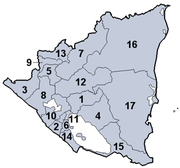
1 Boaco ( Boaco)
2 Carazo ( Jinotepe)
3 Chinandega ( Chinandega)
4 Chontales ( Juigalpa, Chontales)
5 Estelí ( Estelí)
6 Granada ( Granada)
7 Jinotega ( Jinotega)
8 León ( León)
9 Madriz ( Somoto)
10 Managua ( Managua)
11 Masaya ( Masaya)
12 Matagalpa ( Matagalpa)
13 Nueva Segovia ( Ocotal)
14 Rivas ( Rivas)
15 Río San Juan ( San Carlos)
Autonomous Regions
16 RAAN ( Bilwi)
17 RAAS ( Bluefields)
Occupying a landmass of 129,494 km² - roughly the size of Greece or the state of New York and 1.5 times larger than Portugal, Nicaragua contains 7% of the world's biodiversity and the second largest rainforest in the Americas. Close to 20% of the country's territory is protected as national parks or biological reserves. The country is bordered by Costa Rica on the south and Honduras on the north, with the Caribbean Sea to the east.
Nicaragua is a unitary republic. For administrative purposes it is divided into 15 departments (departamentos) and two self-governing regions (autonomous communities) based on the Spanish model. The two autonomous regions are Región Autónoma del Atlántico Norte and Región Autónoma del Atlántico Sur, often referred to as RAAN and RAAS, respectively. Until they were granted autonomy in 1985 they formed the single department of Zelaya.
Nicaragua has three distinct geographical regions: the Pacific Lowlands, the North-Central Mountains and the Atlantic Lowlands.
The Pacific Lowlands
Located in the west of the country, these lowlands consist of a broad, hot, fertile plain. Punctuating this plain are several large volcanoes of the Maribios mountain range, including Mombacho just outside Granada, and Momotombo near León. The lowland area runs from the Gulf of Fonseca to Nicaragua's Pacific border with Costa Rica south of Lake Nicaragua. This region is the most populous. About 27% of the nation's population lives in and around Managua, the capital city, on the southern shores of Lake Managua.
In addition to its beach and resort communities, the Pacific Lowlands is also the repository for much of Nicaragua's Spanish colonial heritage. Cities such as Granada and León abound in colonial architecture and artifacts.
The Central Region
This is an upland region away from the Pacific coast, with a cooler climate than the Pacific Lowlands. About a quarter of the country's agriculture takes place in this region, with coffee grown on the higher slopes. Oaks, pines, moss, ferns and orchids are abundant in the cloud forests of the region.
Bird life in the forests of the central region includes the Resplendent Quetzal, goldfinches, hummingbirds, jays and toucanets.
The Atlantic Lowlands
This large rainforest region, with several large rivers running through it, is very sparsely populated and is the second-largest rainforest in the Americas after the Amazon in Brazil. The Río Coco forms the border with Honduras. The Caribbean coastline is much more sinuous than its generally straight Pacific counterpart. Lagoons and deltas make it very irregular.
Nicaragua's tropical east coast is very different from the rest of the country. The climate is predominantly tropical, with high temperature and high humidity. Around the area's principal city of Bluefields, English is widely spoken along with the official Spanish and the population more closely resembles that found in many typical Caribbean ports than the rest of Nicaragua.
A great variety of birds can be observed including eagles, turkeys, toucans, parakeets and macaws. Animal life in the area includes several different species of monkeys, ant-eaters, white-tailed deer and tapirs.
See also:
- Volcanoes of Nicaragua
- List of cities in Nicaragua
Economy
Nicaragua's economy has historically been based on the export of cash crops such as bananas, coffee and tobacco. Nicaragua's rum is renowned as among the best in Latin America, and its tobacco and beef are also well regarded. During the Sandinista War in the early 1980's, much of the country's infrastructure was damaged or destroyed, and inflation ran for a time at several thousand per cent. Since the end of the war almost two decades ago, many state-owned industries have been privatized. Inflation has been brought to manageable levels, and the economy has grown quite rapidly in recent years.
As in many other developing countries, a large segment of the economically poor in Nicaragua are women. In addition, a relatively high percentage of Nicaragua's average homes have a woman as head of household: 39% of urban homes and 28% of the rural ones.
The country is still a recovering economy and it continues to implement further reforms, on which aid from the IMF is conditional. In 2005, finance ministers of the leading eight industrialized nations ( G-8) agreed to forgive Nicaragua's foreign debt, as part of the HIPC program. As of 2004, Nicaragua is the 4th poorest nation in the Americas after Bolivia, Honduras and Haiti, with a per capita GDP of around $2,900. Unemployment is officially around 11%, and another 36% are underemployed.
The Nicaraguan unit of currency is the Córdoba (NIO) and was named after Francisco Hernández de Córdoba its national founder.
Tourism
In the last 15 years or so, the tourism sector has seen an economic boom, positively affecting the Nicaraguan life and economy. Since 2001, $600 million dollars have been invested in tourism, most of them coming from Nicaraguan and American investors. The country is mostly famous for its landscapes, flora and fauna, culture, beaches and of course, its lakes and volcanoes.
According to the Ministry of Tourism of Nicaragua, the colonial city of Granada, Nicaragua is the preferred spot for tourists. Also, the cities of León, Masaya, Rivas and the likes of San Juan del Sur, San Juan River, Ometepe, Mombacho Volcano, Corn Island & Little Corn Island, and others are main tourist attractions. In addition, ecotourism and surfing attract many tourists to Nicaragua.
The economic benefits which can be derived from tourism cannot be disputed; today, tourism constitutes around 10% of the Nicaraguan income. More investment and support from the government is expected after the Central American-Dominican Republic Free Trade Agreement was signed.
Demographics
According to the 2005 census, Nicaragua has a population of 5,483,400, an increase of 20% on the 1995 census figure of 4,357,099.
Nicaraguans of European or mixed European and indigenous stock ( mestizos) make up a combined 86% of the population, with about 69% being mestizos and 17% being of European descent (mostly Spanish, German, Italian and French).
In the nineteenth century, there had been a substantial indigenous minority, but this group was also largely assimilated culturally into the Hispanic mainstream. Primarily in the 19th century, Nicaragua saw several waves of immigration from other European nations. In particular the northern cities of Esteli and Matagalpa have significant fourth generation German communities. Most of the Mestizo and European descent population live in the western regions of the country as in the cities of Managua, Granada and Leon..
About 9% of Nicaragua's population is black, or Afronicaragüense, and mainly resides in the country's sparsely populated Caribbean or Atlantic coast. The black population is mostly of West Indian (Antillean) origin, the descendants of indentured labourers brought mostly from Jamaica and Haiti when the region was a British protectorate. Nicaragua has the second largest black population in Central America after Panama. There is also a smaller number of Garifuna, a people of mixed Carib, Angolan, Congolese and Arawak descent.
The remaining 5% is comprised of the unmixed descendants of the country's indigenous inhabitants. Nicaragua's pre-Colombian population consisted of the Nahuatl-speaking Nicarao people of the west after whom the country is named, and six other ethnic groups including the Miskitos, Ramas and Sumos along the Caribbean coast. While very few pure-blooded Nicarao people still exist, the Caribbean peoples have remained distinct. In the mid-1980s, the government divided the department of Zelaya - consisting of the eastern half of the country - into two autonomous regions and granted the African and indigenous people of this region limited self-rule within the Republic.
There is also a small Middle Eastern-Nicaraguan community of Syrian, Armenian, Palestinian and Lebanese people in Nicaragua with a total population of about 30,000, and an East Asian community of Japanese, Taiwanese and Chinese people of almost 8,000. These minorities speak Spanish while maintaining their ancestral languages as well.
Culture
The population of Nicaragua is very young with approx. 40% under 18 years of age. The country has strong folklore, music and religious traditions, deeply influenced by Iberian Peninsula culture but enriched with Amerindian sounds and flavours. Nicaragua has historically been an important source of poetry in the Hispanic world, with internationally renowned contributors such as Rubén Darío.
Education is free for all Nicaraguans. Elementary education is free and compulsory, and communities located on the Atlantic Coast have access to education in their native language. Higher education has financial, organic and administrative autonomy, according to the law. Also, freedom of subjects is recognized.
Nicaraguan culture can further be defined in several distinct strands. The west of the country was colonized by Spain and its people are mostly Mestizos and European in composition; Spanish is invariably their first language.
The eastern half of the country, on the other hand, was once a British protectorate. English is still predominant in this region and spoken domestically along with Spanish. Both languages are taught in schools. Its culture is similar to that of Caribbean nations that were or are British possessions, such as Jamaica, Belize, The Cayman Islands, etc. Although recent immigration by mestizos has largely influenced younger generations and an increasing number of people are either bilingual at home or speak Spanish only. There is a relatively large population of people of mixed African descent, as well as a smaller Garifuna population. Due to the African influence, in the East Coast, there is a different kind of music. It is the popular dance music called 'Palo de Mayo', or Maypole, which is celebrated during the Maypole Festival, during the month of May. The music is sensual with intense rhythms. The celebration is derived from the British Maypole for May Day celebration, as adapted and transformed by the Afro-Nicaraguans on the Caribbean or Mosquito Coast.
Of the cultures that were present before European colonization, the Nahuatl-speaking peoples who populated the west of the country have essentially been assimilated into the latino culture. In the east, however, several indigenous groups have maintained a distinct identity. The Miskito, Sumo, and Rama peoples still use their original languages, and also usually speak English and/or Spanish. The small Garifuna people speak their own Garifuna language in addition to English and/or Spanish.
Language and Religion
Spanish is spoken by about 90% of the country's population; Nicaraguans speak standard Iberoamerican Spanish with some similarities to Galician Spanish—structurally similar to Argentinian Spanish which uses "vos" instead of "tu" along with the " vos" conjugation, but with a different intonation. The black population of the east coast region has English as its first language. Several indigenous peoples of the east still use their original languages, the main ones being the Miskito, Sumo, and Rama indigenous groups. Nicaraguan Sign Language is of particular interest to linguists.
Roman Catholicism is the major religion, but evangelical Protestant groups have grown recently, and there are strong Anglican and Moravian communities on the Caribbean coast. The 1995 census shows religious affiliation as follows: Roman Catholic 72.9%, Evangelical 15.1%, Moravian 1.5%, Episcopal 0.1%, other 1.9%, none 8.5%.
90% of Nicaraguans live in the Pacific lowlands and the adjacent interior highlands. The population is 54% urban. An estimated 800 thousand Nicaraguans live outside of Nicaragua.


